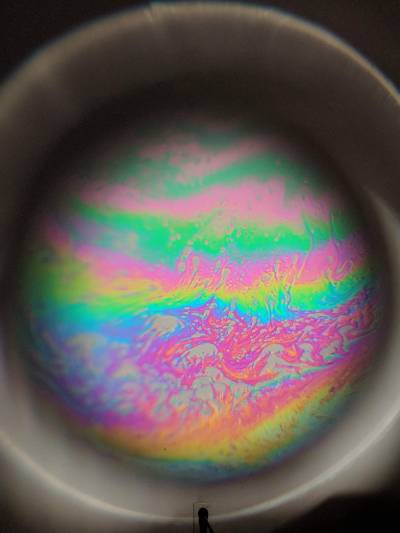Table of Contents
Interference Fringes In A Soap Bubble
Description
Colorful and visually interesting demonstration showing the interference pattern produced by light reflecting off of a soap bubble.
Purpose
To show the interference fringes produced by a thin soap bubble.
Apparatus
In box labeled 'Thin Film Soap Bubble':
- 10cm diameter ring
- lens
- clamp for ring
- solution
- Yellow filter
Additionally:
- A pair of lab stands
Setup
A solution is made out of dish soap, water, and glycerin (to help prolong the life of the bubble). The metal ring is dipped into the solution (a pie plate works well to hold it) and placed into the test stand. The projector is aimed at the bubble film and the reflection is focused onto a distant screen using the lens.
Optionally, you can put the yellow filter in the projector. Then instead of seeing a multicolored interference pattern, a yellow and black pattern will be visible. This may be easier to explain than the multicolored pattern, though it'll be less pretty.
Bubble Solution Recipes
These recipes were made for use with the 10cm diameter ring currently included in the box. For smaller or bigger sizes of bubbles a different solution may be desired.
Some notes on mixing your own: Start with just water and soap. A 50-50 mixture works okay on it's own, but is short lived (~10 seconds). Adding glycerin to the mixture will make the bubble last much longer. The water to glycerin ratio determines how quickly the interference pattern will develop. More glycerin, and it'll take much longer to show. More water and it'll develop much faster, and the horizontal banding due to gravity will also be much more apparent.
Presidents Choice 'Ultra Original 2X' dish soap was used for mixing these.
Bubble Solution No. 1
Interference pattern shows pretty quickly. Somewhat long lived. Horizontal banding due to gravity is strongly evident.
- 300 mL water
- 75 mL dish soap
- 30 mL glycerin
Bubble Solution No. 2
Interference pattern develops more slowly. Very long lived (hours). Some horizontal banding is evident, but since the solution is much thicker it's less dominant. Much greater degree of swirling and complicated shapes.
- 300 mL water
- 100 mL dish soap
- 100 mL glycerin
Notes
Students must be reminded that the lens has inverted the image. Depending on the solution you use, the thinnest portion of the film will therefore be seen at the bottom on the screen as an extended black area just before the bubble breaks.
Formation of interference patterns visible using solution no.1.
Demo room information
| Location | A4 |
| Maker | Unknown |
| Current State | Working |

